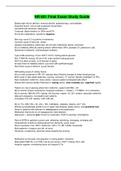Exam (elaborations)
NR601 Final Exam Study Guide (2 Versions, Latest-2022) / NR 601 Final Exam Study Guide: Chamberlain College of Nursing | Latest and Updated Guide|
- Course
- Institution
NR601 Final Exam Study Guide (2 Versions, Latest-2022) / NR 601 Final Exam Study Guide: Chamberlain College of Nursing | Latest and Updated Guide|
[Show more]




